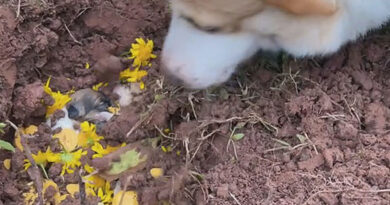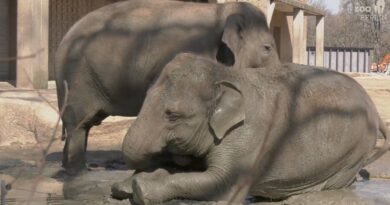A Cat-Sized Aye-Aye Is The Star Attraction Of The Bristol Zoo Gardens
A six-month-old baby aye-aye that has reached the size of a domestic cat is a star attraction of the Bristol Zoo Gardens.
Twilight World is home to the infant aye-aye, named Feo, who was born at Bristol Zoo Gardens in South West England, last November.
Feo, which means ‘vocal’ in Malagasy (the national language of Madagascar ) is the first infant aye-aye to be born at Bristol Zoo Gardens for six years, and one of only two born in European zoos in the past 12 months.
Al Toyne, Mammals Team Leader, said: “Our team has worked really hard and this birth is definitely a great success.
“He spent the first two and a half months inside a nest box but now he is moving around the enclosure and is more independent.
“He is constantly chewing things and has started eating waxworms, but he will return to his mother to feed until he is 18 months old.”
Aye-ayes (Daubentonia madagascariensis)are famous lemurs because they have an extended middle finger with which they beat the bark of the tree, listening to the sound of the grub that moves using their large and rotating ears, which gives them excellent hearing.
Then they tear the wood with sharp teeth and ‘fish’ the food using the special finger.
Toyne said: “It’s fascinating because Feo is watching his mother tapping wood and finding food, and then experimenting himself.”
Keepers ensure that food is placed in hollow tree branches throughout the enclosure so Feo, Tahiry (his mother), Peanut ( dad), and Noah (grandad), all have to look for their food to feed.
Toyne said for visitors to have the best chance of seeing Feo it was worth spending 10 to 15 minutes looking at the other animals in Twilight World first.
He explained: “The aye-ayes’ enclosure is in the darkest part of Twilight World so by the time people reach it their eyes will have adjusted to the level of light.
“Then if people stand quietly and watch, they will be able to see Feo and his family moving around. They are some of the most active animals we have in Twilight World.”
The aye-ayes at Bristol Zoo Gardens are important because in their native Madagascar, the only place where lemurs are found in the wild, they are classified as Endangered.
This is the consequence of their forest habitat being destroyed by people for agriculture and timber. In some areas, they are also killed in the belief that they are a symbol of bad luck.
Bristol Zoological Society has been working in northern Madagascar since 2006 and is involved in building a new research centre in the country, allowing conservationists to study lemurs in their natural habitat, and to ultimately help save them from extinction.
This year zoo staff hopes to create a permanent tree nursery to grow saplings and help establish natural corridors for lemur species, such as the blue-eyed black lemur and Sahamalaza sportive lemur.
The aim is to help bridge gaps and encourage lemurs to move between the forest fragments within the national park to develop larger areas and allow the growth of lemur populations.


